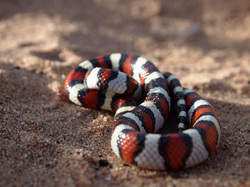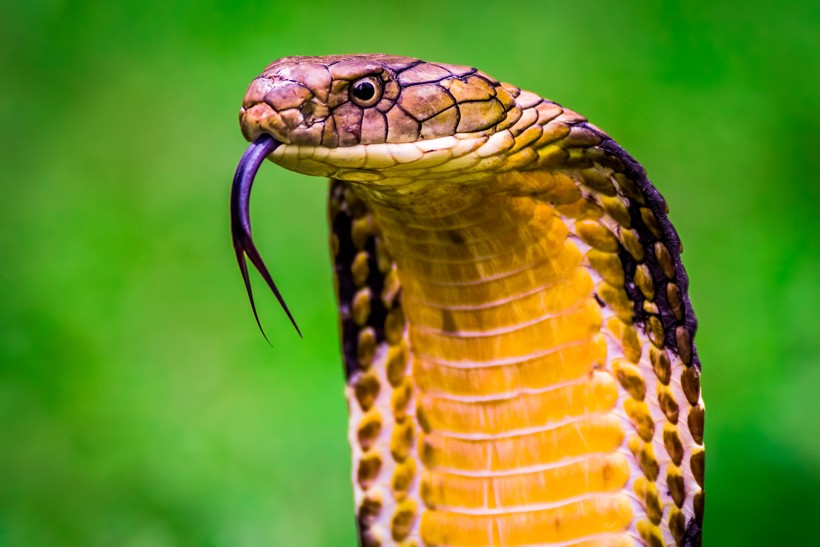
The Deadliest Snakes On Earth
(Other Than Slimy Hagfish Liberals)
Snakes are considered one of the scariest creatures in the animal kingdom, and rightfully so. It has been reported that there are roughly 5.5 million snakebites annually. Of those, 1.8 million are envenomings which lead to over 90,000 deaths. We can thank many of these snakes for those deaths.
The King Cobra is the world’s longest venomous snake. It is predominantly found in India and other parts of Southeast Asia. The King Cobra’s venom’s toxins attack the victim’s central nervous system resulting in pain, vertigo and eventually paralysis. It has been reported that death can occur as short as 30 minutes without the antivenin. The toxin is so deadly, it could even kill a large elephant.

The Saw-Scaled Viper kills more people than any other snake each year. Although it only grows to 1-3 feet long, its venomous bite can do lots of damage. Their venom contains hemotoxins and cytotoxins, which leads to multiple bleeding disorders including the possibility of an intracranial hemorrhage. Many of these snakes are found in areas where modern medicine is not found. Therefore, victims sometimes suffer a long, painful death. Found in the dry regions of Africa.
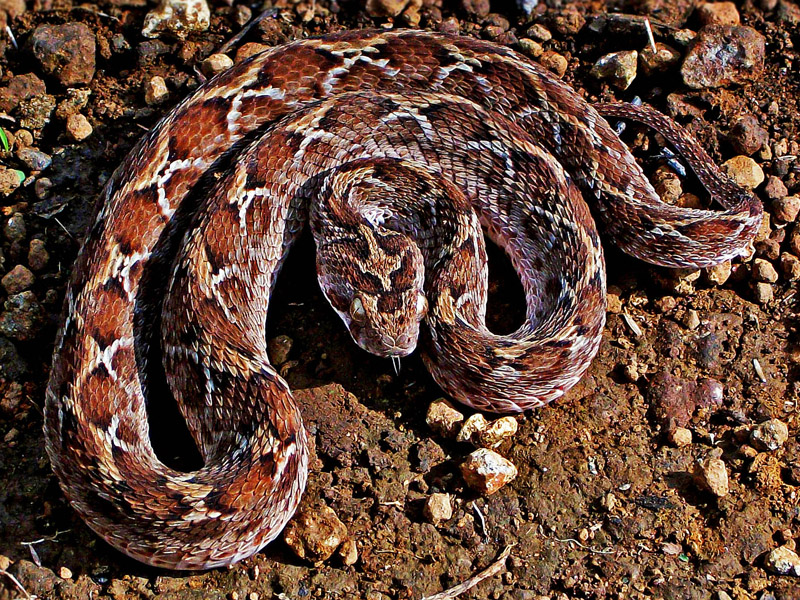
The Black Mamba is found in the savannas and rocky areas in southern and eastern Africa. It can grow up to 14 feet long and can slither up to 12.5 mph, making it the fastest snake in all the planet. Although it only attacks when it is provoked, when it does attack beware. The Black Mamba will bite several times, delivering enough toxins to kill 10 people. There is a antivenin but it must be received within 20 minutes.
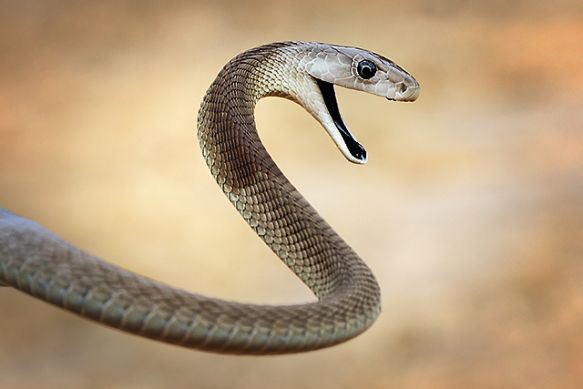
The sub-Saharan African Boomslang, may look cool. However, do not touch! The average adult boomslang is 100–160 cm (3¼–5¼ feet) in length, with extremely large eyes. The boomslang has a highly potent venom that it can deliver through fangs at the back of its jaw. The snake is able to open its jaws 170° when biting. The venom is mainly made of a hemotoxin which disables the coagulation process in a person’s body. Signs and symptoms of a bite may not show until hours after.
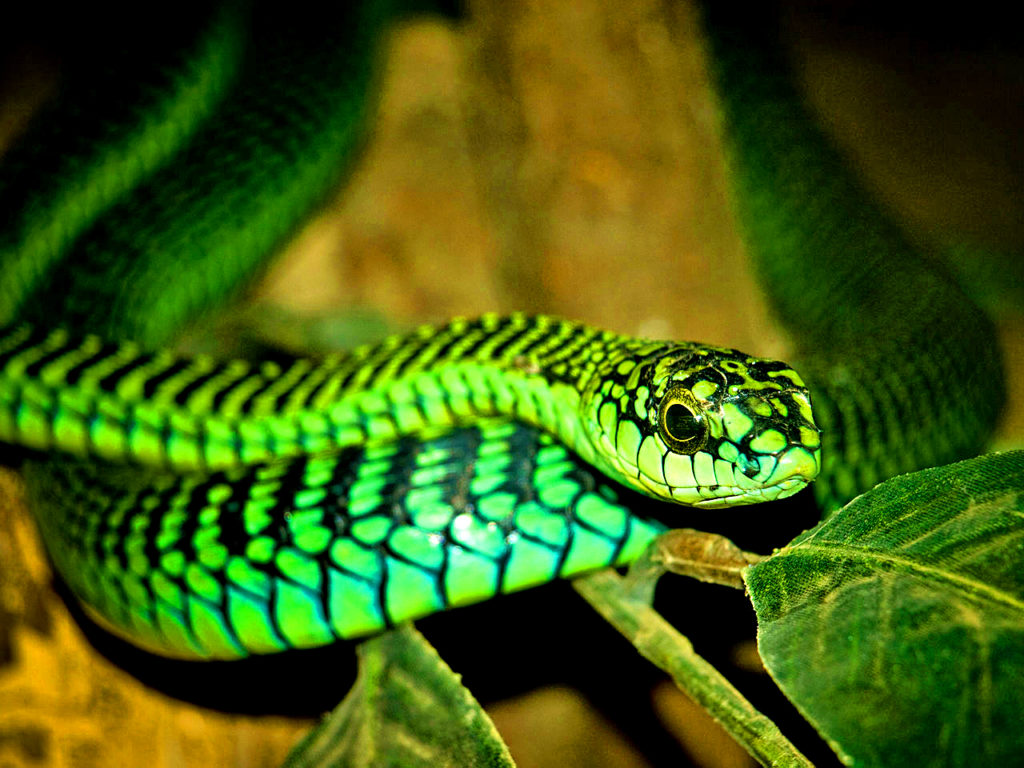
Tiger Snakes are found in the southern regions of Australia and some of its costal islands. It gets in name from its color, as it is often banded like a tiger. A tiger snake’s venom contains many potent toxins. Once bitten a person will experience, at first, localized pain followed by breathing difficulties and finally paralysis. Studies show that untreated bites have a mortality rate of 40-60%.
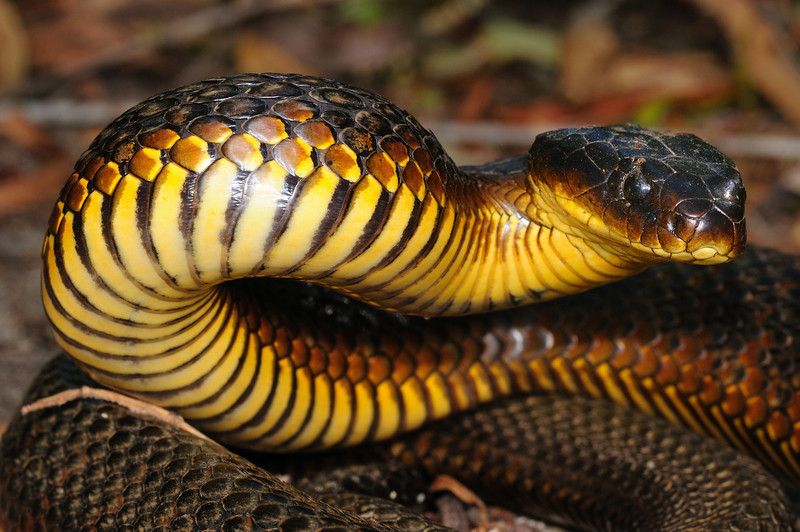
The Inland Taipan is the most venomous of all the snakes in the world. What also separates this snakes from many others is its prey. The snake is an expert in hunting mammals, therefore, its venom is adapted to kill warm-blooded species. It normally does not strike unless provoked. Its venom contains neurotoxins which affect the nervous system, hemotoxins which affect the blood, and myotoxins which affect the the muscles. If untreated the venom can be lethal.
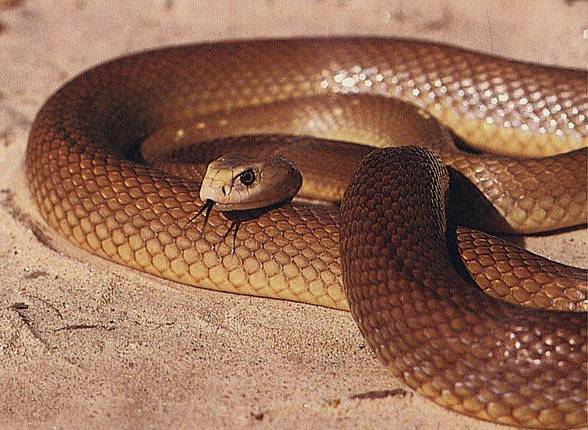
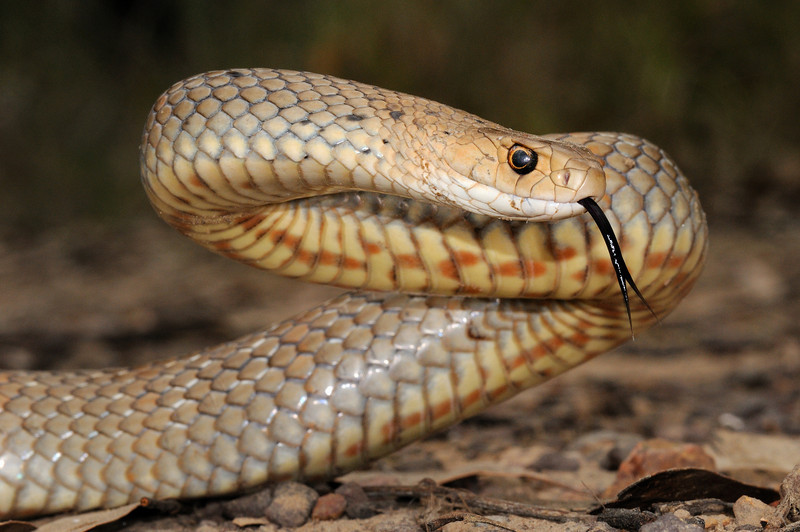
The common lacehead, also known as the bothrops atrox, inhabits the tropical lowlands of nothern South America. The species of pit-viper is easily agitated and is generally nocturnal. However, when necessary it may forage through the day, climbing trees and even swimming. It is often times found in coffee and banana plantations searching for rodents. Therefore, due to their camouflage, workers do not see the snakes and are often bitten. The venom is very lethal and fast acting. Even when received treatment, almost all cases lead to temporary or sometimes permanent memory loss.
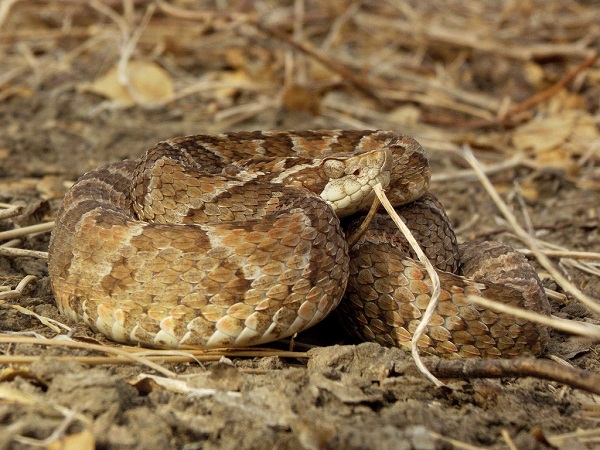
According to National Geographic “The eastern diamondback rattlesnake is the largest venomous snake in North America. Some reach 8 feet (2.4 meters) in length and weigh up to 10 pounds (4.5 kilograms).” Despite what people think the eastern diamondback rattlesnake will not attack humans unless it feels threatened. Bites normally happen when a person is taunting or trying to capture the snake. The last warning before a bite is when the snake violently shakes its tail. Bites can result in red blood cells deterioration, tissue damage, and if left untreated, death.
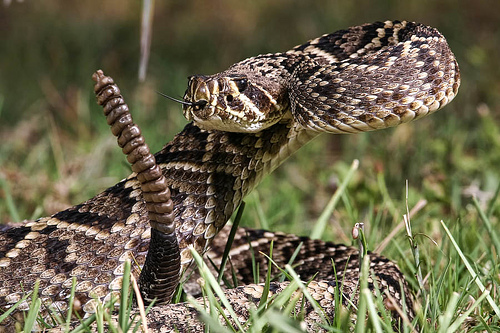
The western diamondback rattlesnake inhabits the southwestern area of the United States. It has been reported that it is most likely responsible for the majority of snakebite fatalities in northern Mexico and the largest number of snakebites in the U.S. The western diamondback rattlesnake has very large venom glands and special fangs so it can deliver a large amount of venom to its victims. However, as it normally preys on small mammals, it will only bite a human if provoked.
Bite victims very commonly have been drinking alcohol and provoking the snake.
Leave them alone!
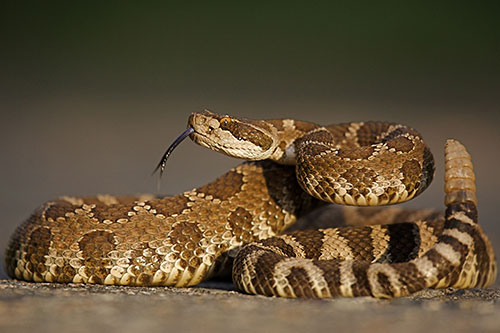
If you see a Philippine Cobra, you better run away. These cobras are highly venomous and are capable of accurately spitting their venom at a target up to 3 meters (9.8 feet) away. The Philippine cobra is normally found in forested areas, along open fields. They are also fond of water, and therefore, can be found many times close to ponds and rivers. Small rodents are the preferred prey of their choice.
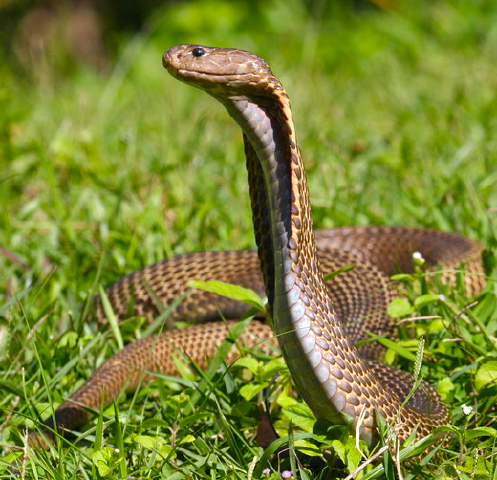
The puff adder is found in African savannah and grasslands, and is the most commonly found snake on the continent. Due to its commonality, it is responsible for causing the most snakebite fatalities in Africa. If they feel threatened or disturbed, they will adopt a tight coiled posture and the fore part of their body will form an “S” shape. They are very aggressive and strike very fast.
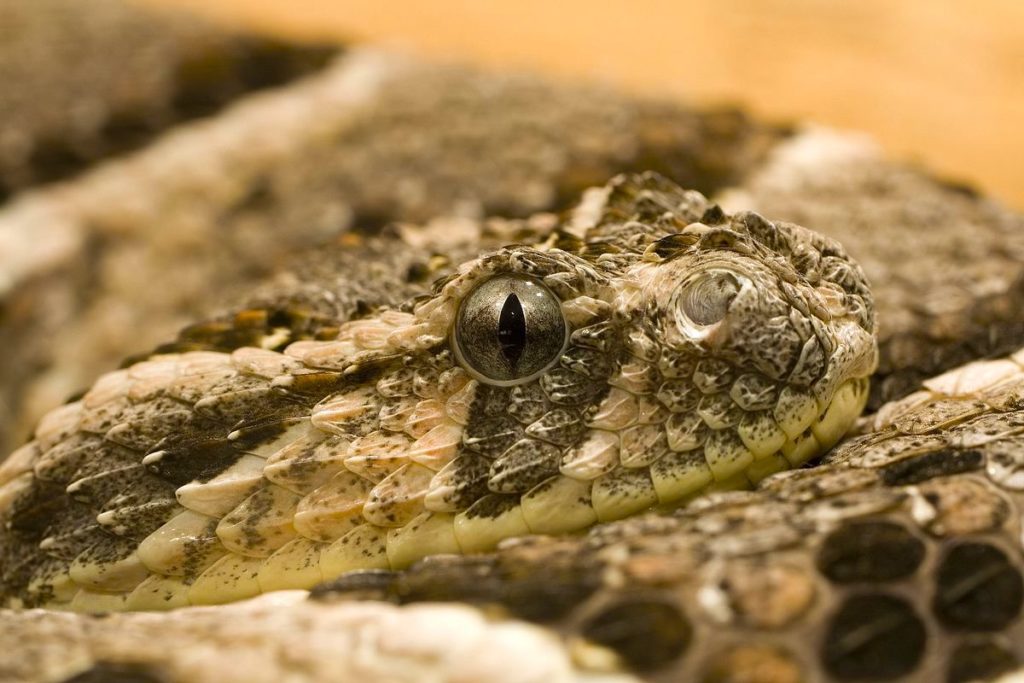
Made popular by snake charmers, the Indian cobra is found all over the Indian subcontinent. It is a member of the “big four” species, the 4 species that inflict the most snakebites on humans in India. However, as it’s admired in Indian culture, it is protected under the Indian Wildlife Protection Act. Its venom mainly consists of neuro and cardiotoxins. This means a bite can lead to paralysis of the muscles or even cardiac arrest. Symptoms can show anywhere between 15 minutes to 2 hours after the bite.
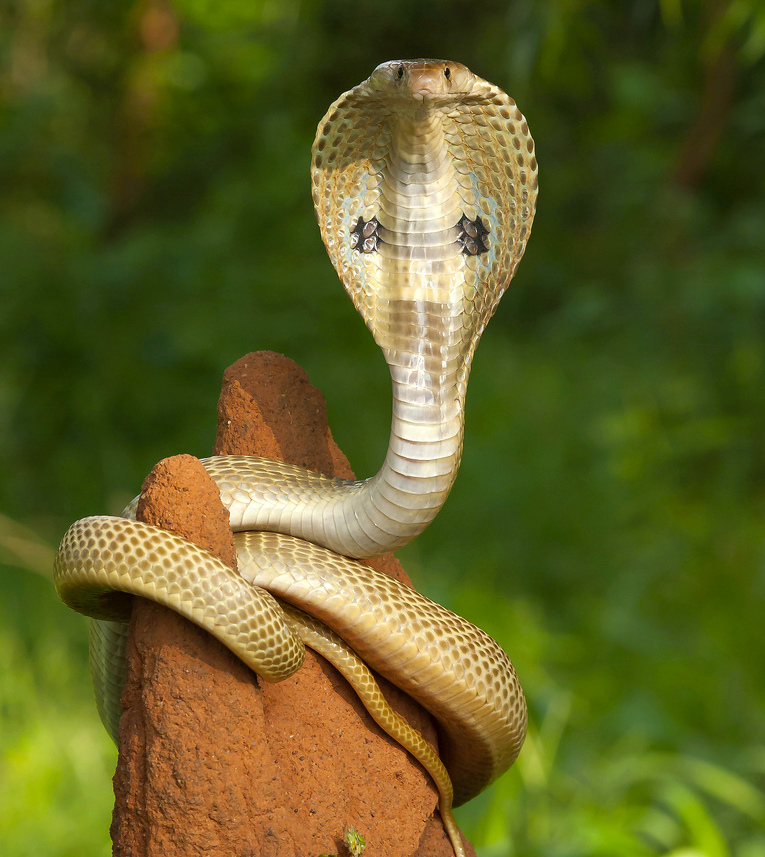
Russell’s viper is found in the Indian subcontinent and southeast Asia. Like the Indian Cobra it is considered on of the “big four” species. Russell’s viper can grow up to 166 centimeters (5.5 feet) in length. The snake is often times found in high urbanized areas due to the attraction of rodents. Therefore, those working in fields outside of cities are at a high risk of being bitten.
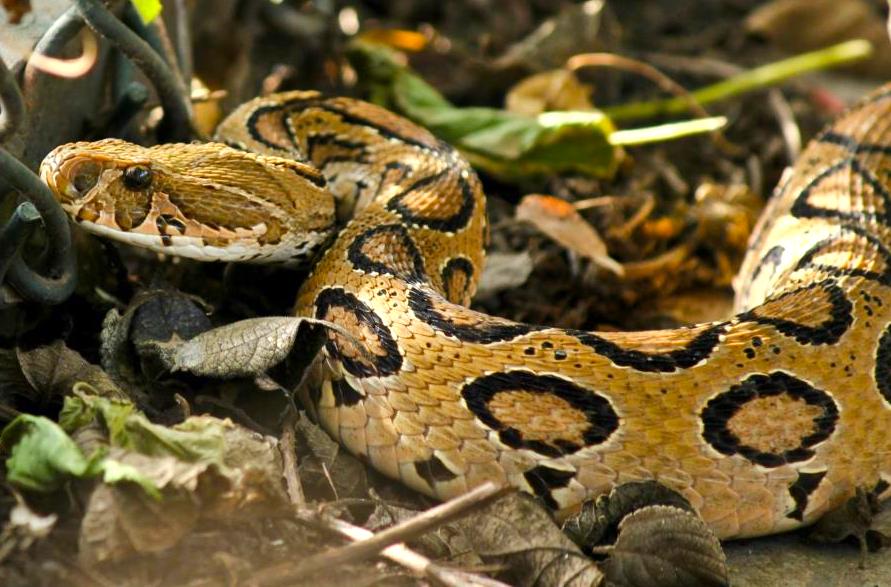
A member of the “big four” species in India, the common krait, is also known as the blue krait. The common krait feeds on other snakes and small mammals. Although reluctant to bite people, if it does, it will clasp and hold for awhile in order to inject a large amount of venom. The venom consists of mostly powerful neurotoxins leading to muscle paralysis.
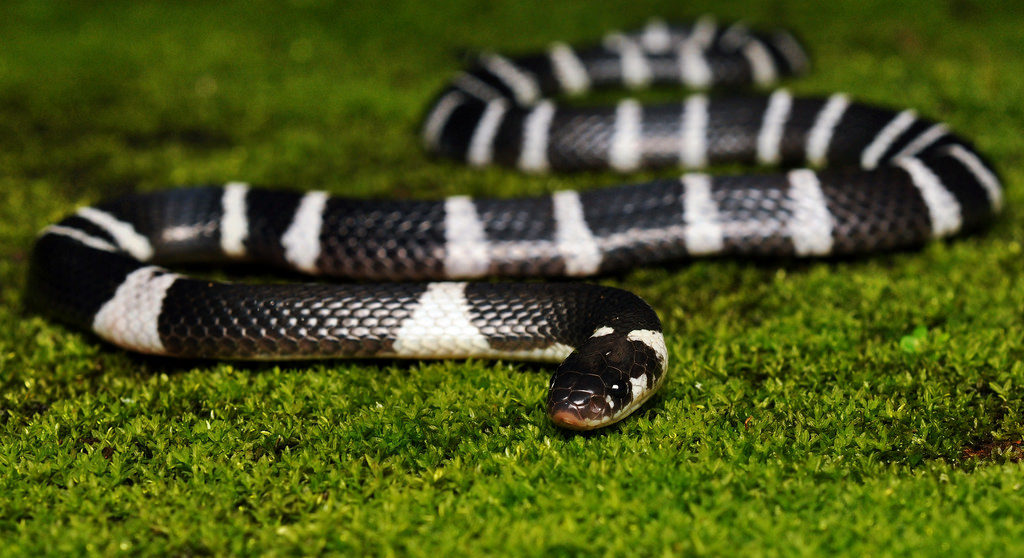
The terciopelo viper is one of the most dangerous snakes in the neotropical rainforest in Central America. They can grow up to 2.5 meters (8 feet) long and have heads that are 10 centimeters (4 inches) wide. They are responsible for the majority of snakebites in Central America. Their venom contains hemotoxins and if not treated with an antivenin can lead to death.
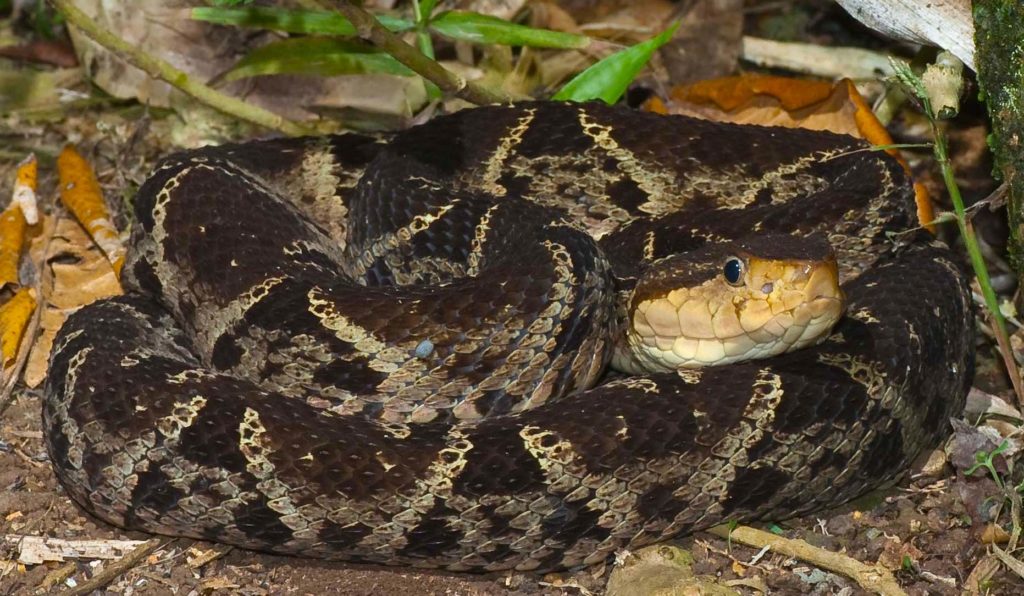
Also known as the Taiwanese or Chinese Krait, the many-banded krait is a highly venomous snake found in southern China and Southeast Asia. In the daytime, this snakes hides in places such as holes and under rocks. However, at night, it hunts and becomes more aggressive. Symptoms will not appear promptly after bite, but may show hours later. If untreated, death is likely 70-100% of the time.
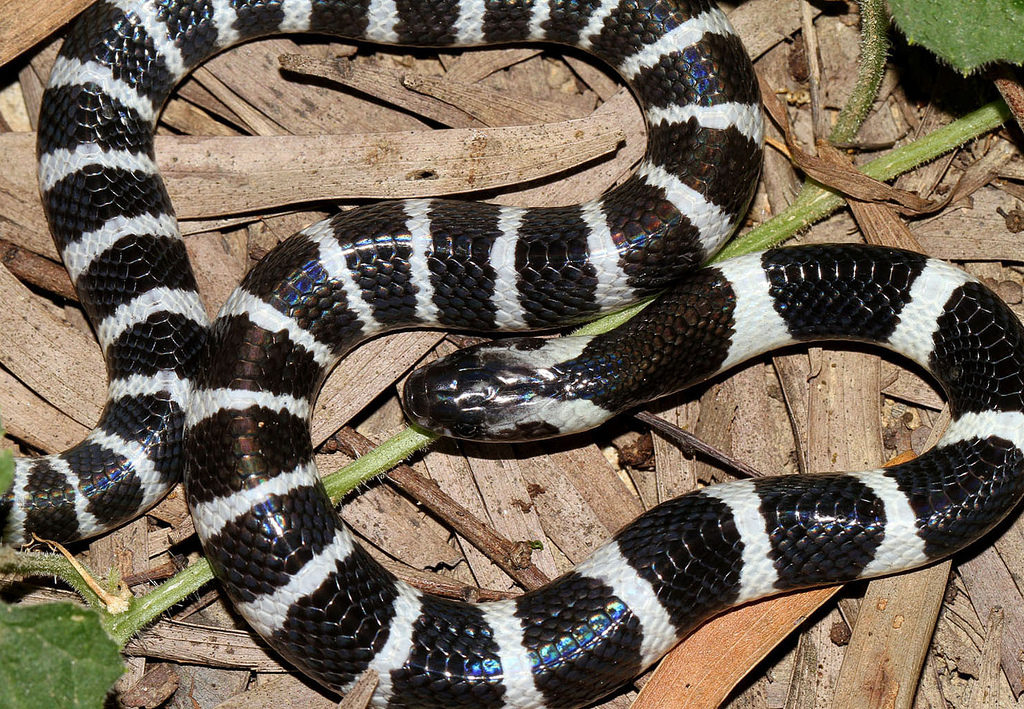
The Malayan krait inhabits Thailand and much of Southeast Asia. They tend to shy away from the sun and are very active at night. Their venom is highly poisonous and death can result as soon as 12-24 hours after bite. Sadly, even after treatment, 50% of its victims will succumb to effects of the poison, dying usually from respiration failure.
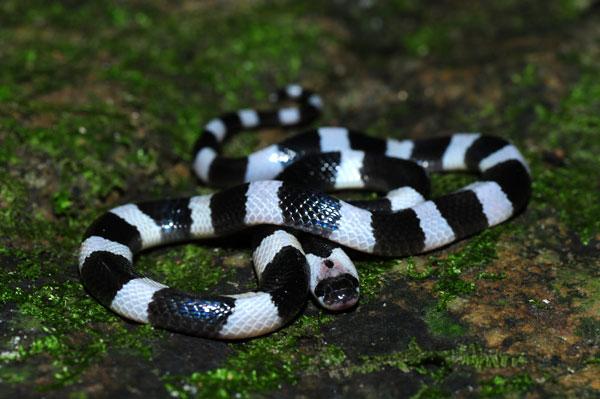
The common death adder is native to Australia. Not only is it one of the most venomous snakes in Australia, but also the whole world. The death adder is a master of camouflage and likes to hide beneath loose leaves in woodlands and grasslands. Its venom contains a very potent neurotoxin which can lead to death within 6 hours after the bite.
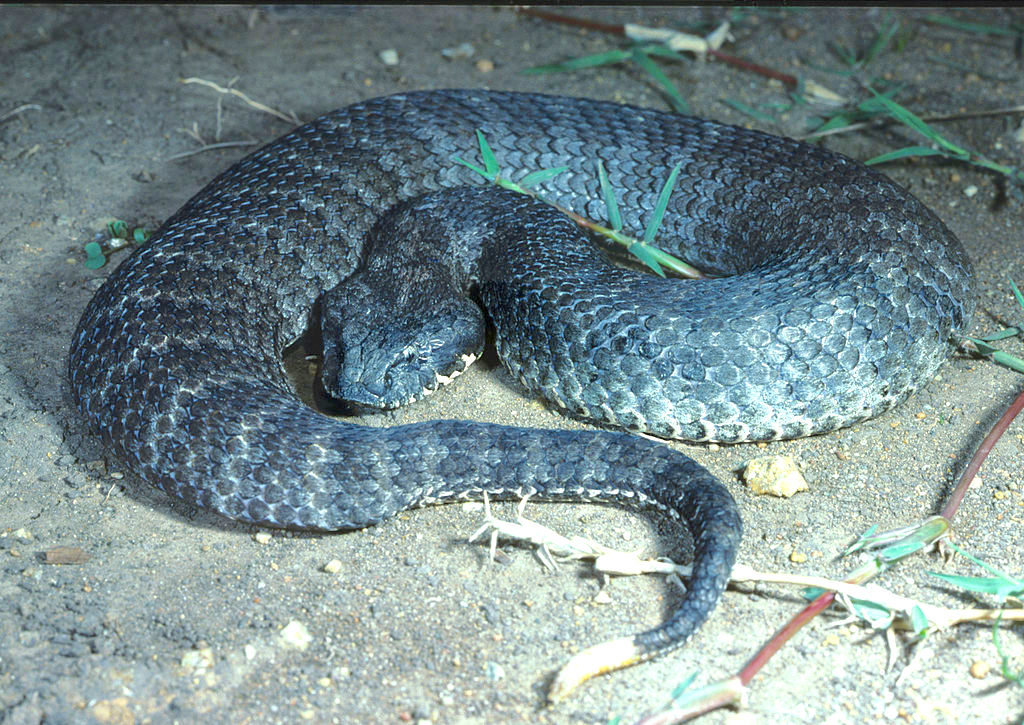
The eastern green mamba resides in East Africa and is normally found dwelling in trees. This highly venomous snake can grown up to 2 meters (6.6 feet) in length. This species has bitten many humans, many of which have resulted in fatalities. There was one case where someone died in as little as 30 minutes after the bite. Other symptoms of the venom include difficulty breathing, convulsions and nausea.
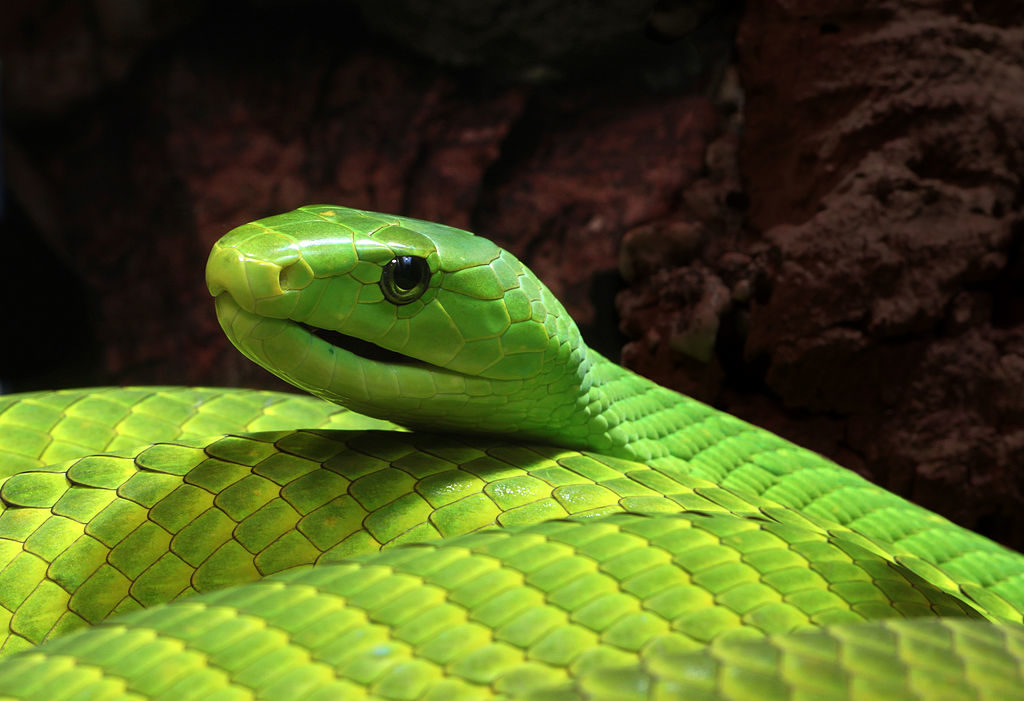
The western green mamba, as you would suspect, resides in west Africa. However, bites to people from this snake are very uncommon. However, when people are bitten the mortality rate is extremely high. Once bitten there is a rapid progression of life-threatening symptoms including suffocation resulting from paralysis of the respiratory muscles. Death has been also been reported to occur within 30 minutes of the bite.
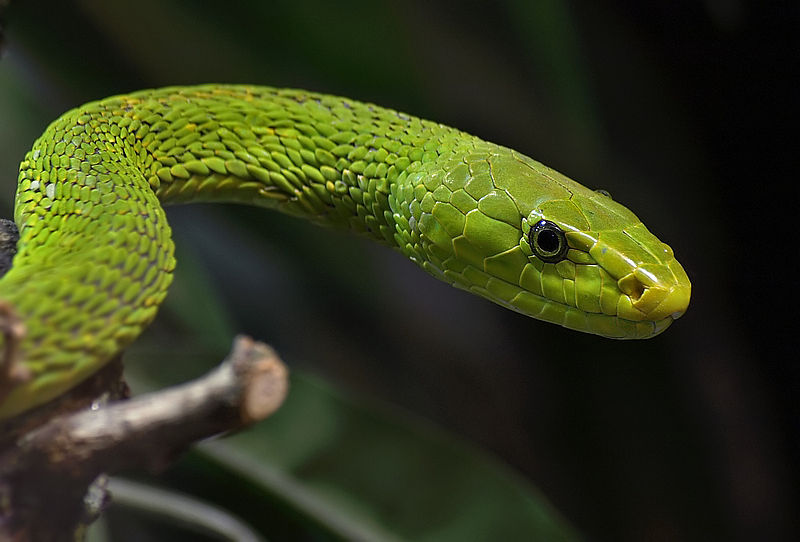
The forest cobra is native to Africa, mainly dwelling in the central and western parts of the continent. Its preferred habitat in the lowland forest and moist savannah. However, it can be found in drier climates and is a very good swimmer. Although bites to humans are rare, they are very dangerous when they occur. This snake injects a large amount of venom into its victims. Death can occur 30-120 minutes after being bitten.
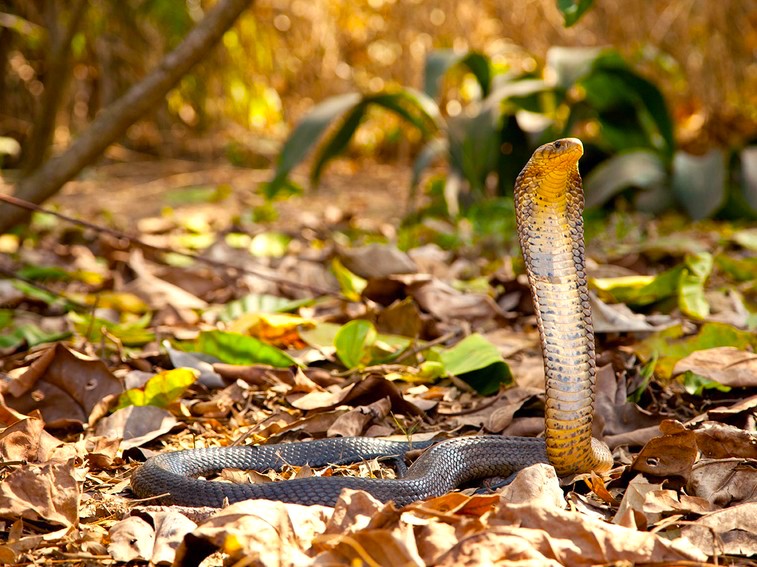
The jararaca is a species of pit-viper found in southern Brazil, Paraguay, and northern Argentina. The snake prefers to live in open areas, such as farmland. Its venom is considered very toxic and causes symptoms such as bruising and blistering of the affected limb and spontaneous systemic bleeding of the gums and into the skin. However, one good thing was derived from the venom, the ACE inhibitor, which is used to treat hypertension and some types of congestive heart failure.
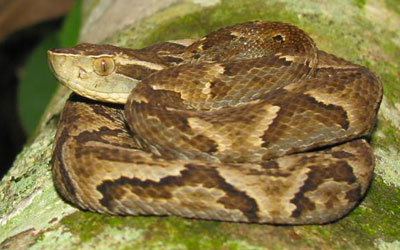
The longest snakes in the western hemisphere are the South American Bushmasters. In addition, they are the longest pit-viper in the world. They inhabit parts of South America and tend to dwell in equatorial forests. The primarily feed on mice and rats, but will attack when provoked. Unfortunately, not much is known about their venom as they are highly susceptible from stress. Therefore, they die quickly when in captivity.
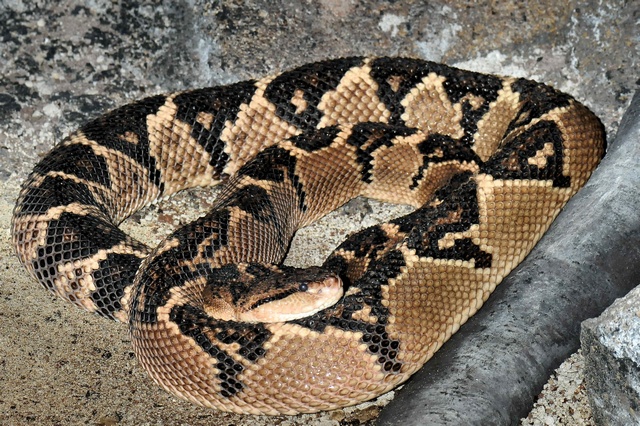
The Cape Cobra is considered one of the most dangerous snakes in Africa due to its highly potent venom and its common occurrences around houses. The mortality rate for bites from a cape cobra are unknown, but are believed to be high. If a victim does not receive the antivenin it is likely he or she will die from respiratory failure.
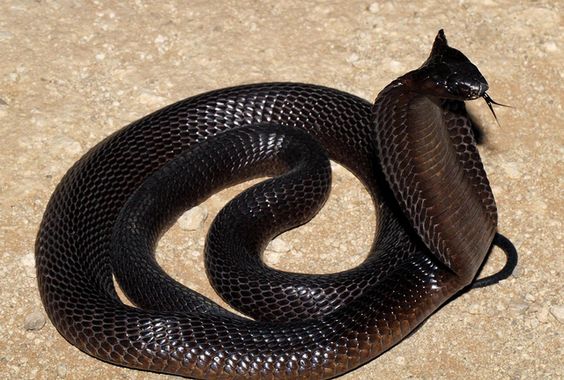
The Sharp-nosed pit viper is found in southeast Asia. Its highly potent venom contains hemotoxin that is very likely to lead to hemorrhaging. Its nickname is the “hundred pacer.” It has been believed that victims will only be able to walk 100 steps before dying. However, there is an antivenin made in Taiwan. Symptoms from a bite include swelling, blistering, necrosis, and ulceration
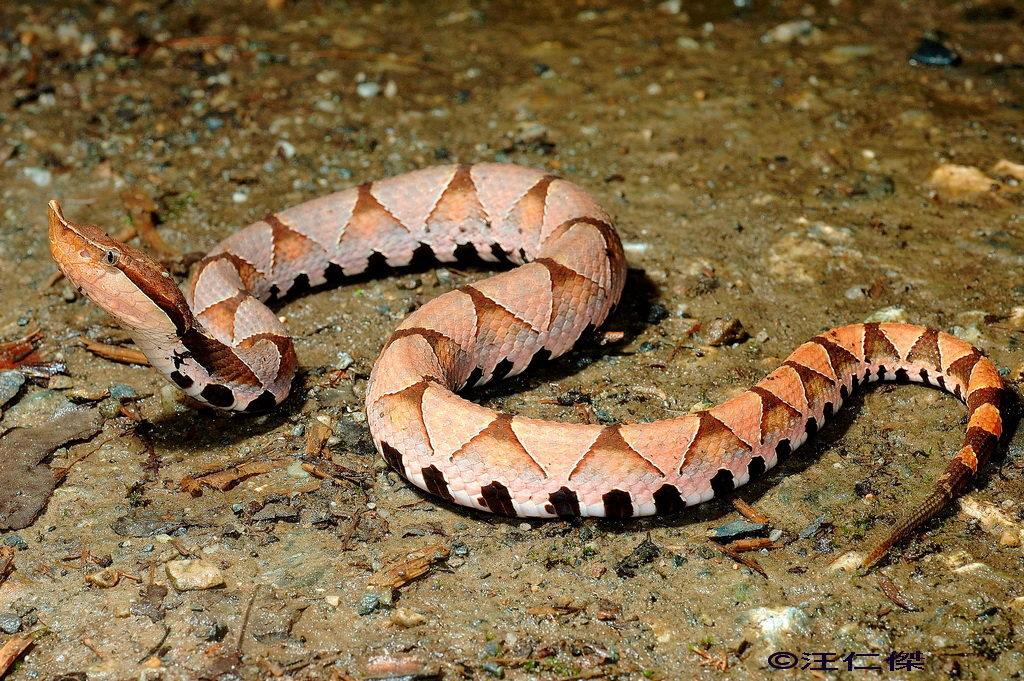
Keep your distance from this snake, as the black-necked spitting cobra can eject venom from its fangs over 7 meters (23 feet) with perfect accuracy. They are mainly found in just sub-Saharan Africa and can grow up to 2.2 meters (7.2 feet) long. Bites can lead to blisters, inflammation and permanent blindness if venom makes contact with the eyes.
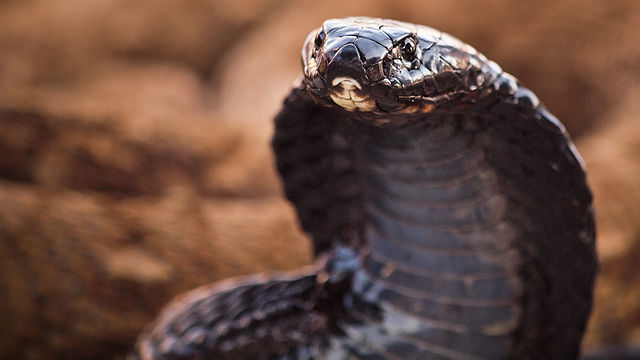
The Gaboon viper lives in the rainforests and savannas of sub-Saharan Africa. It is the worlds heaviest viperid and has the longest fangs of 5 centimeters (2 inches). It is normally slow moving and placid, and they are known for lying in wait for hours for their prey to pass by. Due to their docile nature, bites normally only occur when they are stepped on. However, it should be considered a medical emergency when a bite does occur.
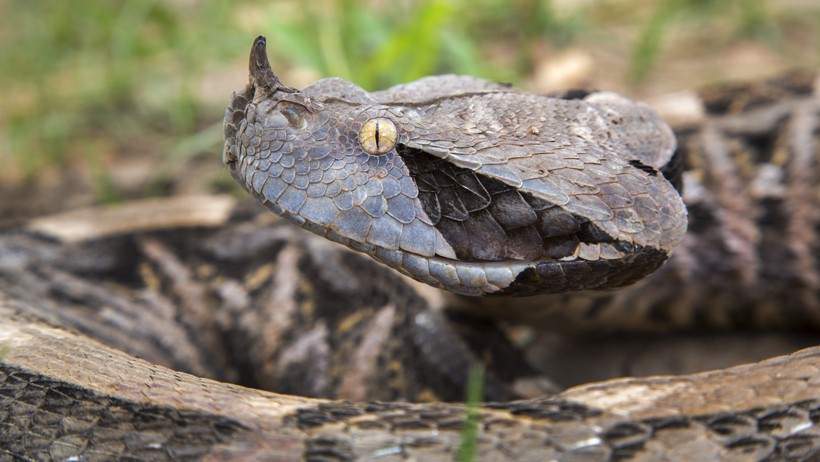
The dugite is a venomous snake found in western Australia. Dugites are normally shy and will slither away upon seen a human. However, like many other snakes will attack if they feel cornered. Dugites are considered highly dangerous due to their very potent venom that causes both coagulopathic and procoagulant effects. Although they rarely bite humans, when they do, it is normally during when they are most active in their mating season (October and November).
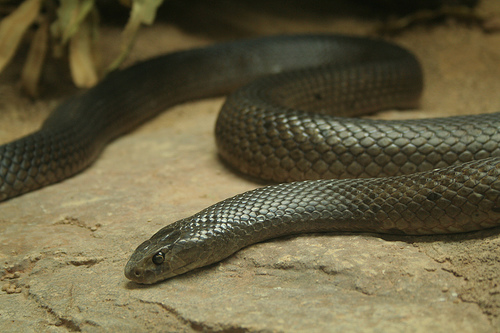
The Caspian cobra is found in central Asia. This snake is known for being very aggressive and bad-tempered. They tend to avoid humans, but will become aggressive towards them if they feel threatened. When feeling threatened it will spread its hood, hiss, and sway side-to-side, then finally strike its target multiple times. Once bitten a person may experience drowsiness, weakness, paralysis of the limbs. If untreated, the bite can result in death from respiratory failure
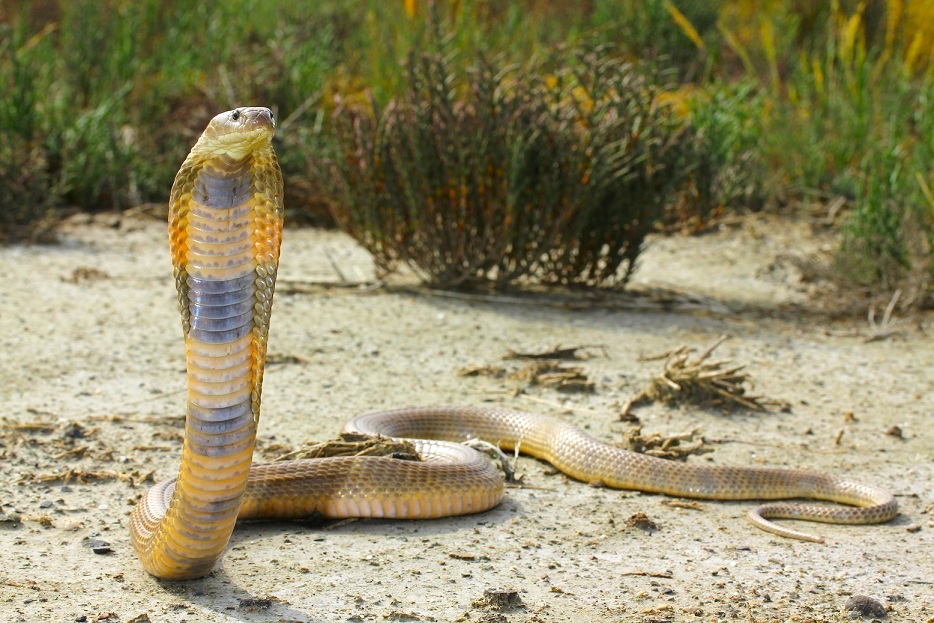
Cottonmouth snake
The Cottonmouth snake, or (A. piscivorus), is one that many refer to by names such as the Water Moccasin, or a combination of variations: Cottonmouth Moccasin, Highland Water Moccasin, and North American Water Moccasin.
The explanation for its name is the bright white lining of the mouth that it displays as a warning to predators and prey alike.
Cottonmouth snakes mate annually every spring and, after a gestation period of three to four months, the female gives live birth to up to 16 juvenile snakes. The neonates have an average length of 8 to 14 inches. The eggs hatch within the female body - this is described in the literature as ovoviviparity. Neonate Cottonmouths are venomous as juvenile.
Males typically fight one another for the right to mate with the females.
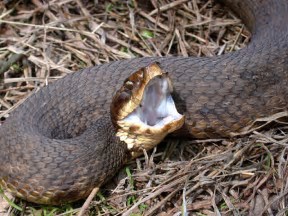
Copperhead Snake
The Copperhead is the most mis-identified snake in America! Did you see EXACTLY the below snake? Are you sure? It wasn't just one of a number of similar looking snakes, mostly water snakes such as the Northern Water Snake? Snakes can be very tricky to identify. Copperheads are rare, and people do see them, so heck, maybe you did. In some areas they are more common than in other areas.
Copperhead Appearance: Copperhead snakes are considered a medium sized snake with a wide body and a broad head. The snake has a distinctive neck, unlike in other species where that characteristic is indistinguishable. These snakes can be a light brown or tan in color with dark, irregular banding. The bands can be solid in color or can have a fading color appearance from the outside to the inside, from dark to light pigment. The markings often resemble a triangular shape, helping the snake to blend in with leaves on a forest floor.
The well-known copperhead snake, though not hugely common, has a fairly large range, is most often found within the eastern coast of North America and the midsouthern states, along the Mississippi drainage. This snake prefers the cover of forest, though it will often make its home or den in rocky areas and ledges. Some subspecies have adapted to life in marshy regions, living off the ample food sources found along the waterways.
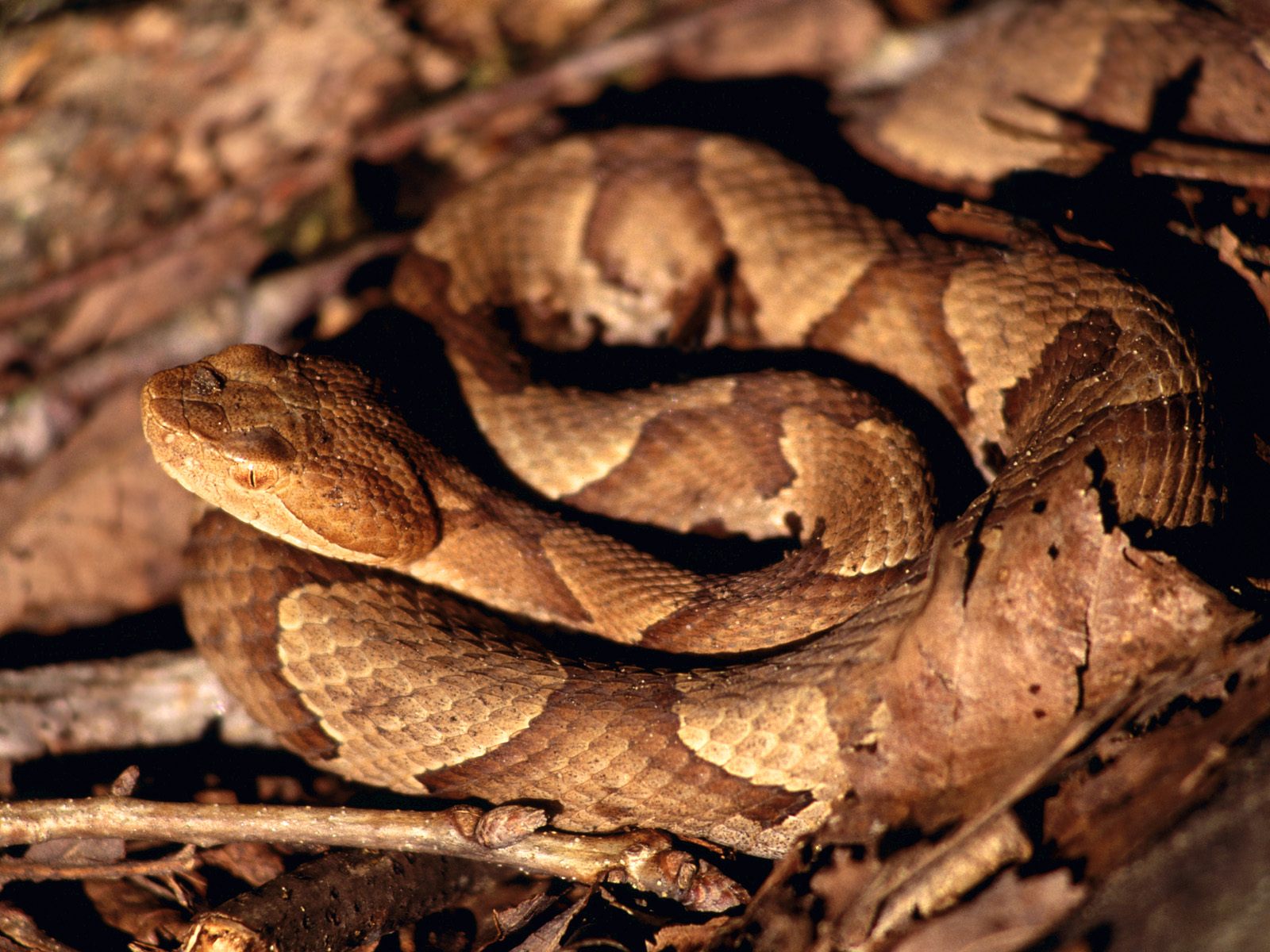
Coral Snake
There are many varieties of coral snakes throughout the Americas, but we will address the USA snakes. The most common species in the United States have a universal red-yellow-black-yellow pattern. Not all coral snakes have the same color scheme, so it is important to be familiar with the snakes specific to your region. This snake is small in comparison to other venomous snakes in the United States. At its longest, an adult can measure around thirty inches. The colorful body is slender and lacks real variance in width. The head blends seamlessly into the body with no distinctive neck. The head of this species of coral snake is always black.
Unlike other venomous snakes, the coral snake has round pupils, a blunt head, and no heat sensing pits. Its venom sacks are not attached to the fangs but are adjacent to the teeth, permeating the puncture holes as the snake latches onto a victim. Contrary to common belief, the maximum amount of venom can be delivered without chewing; the venom delivery is related to the duration of time the snake is attached, not how many times it bites its prey. Multiple bites do facilitate quicker venom transfer, but do not necessarily affect the quantity.
Coral snake venom is neurotoxic, another fact which distinguishes it from other North American poisonous snakes. Neurotoxic venom affects the way the brain communicates with muscles, slurring speech, affecting movement, and ultimately ceasing cardiac or respiratory function. A bite from a coral snake can go without symptoms for as long as twelve hours.
A variety of rhymes have been developed to properly identify a coral snake. “Red on yellow, kill a fellow. Red on black, friend of Jack” is just one variation. No deaths from a coral snake bite have been reported since 1967 when the antivenin was developed.
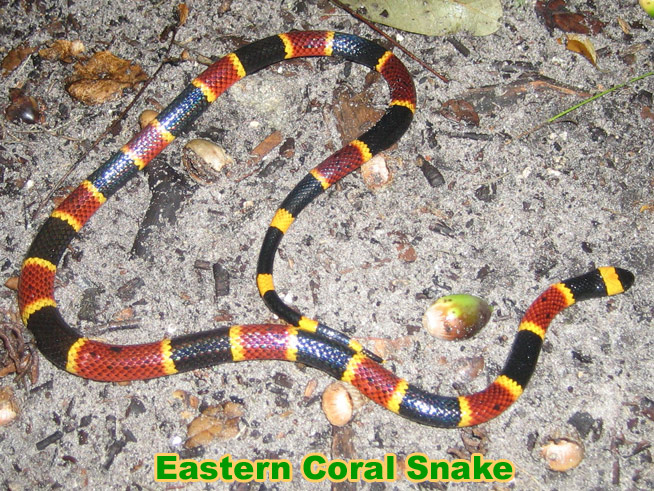
Milk Snake resembals Coral Snake
